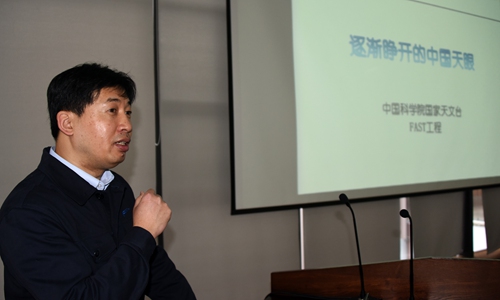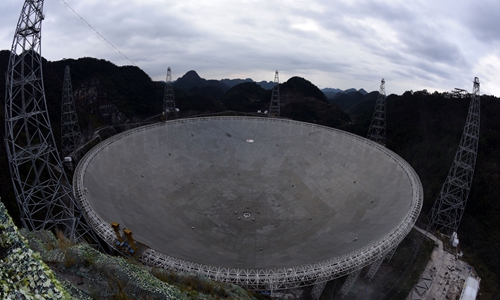HOME >> CHINA
The man behind China’s signature project to reach for the stars
By Global Times – Agencies Source:Global Times Published: 2020/1/22 19:43:40

Jiang Peng Photo: cnsphoto
"FAST is actually a radio telescope that works like satellite TV antennas, except it is big enough to point to all directions with a diameter of 500 meters and a clear aperture of 300 meters," Jiang Peng explained in a short video released by the Xinhua News Agency on January 13.
Jiang is the chief engineer of China's Aperture Spherical Radio Telescope (FAST), known as the China sky eye, which started formal operation on January 11 in Southwest China's Guizhou Province.
The astronomical telescope is made of 4,450 individual panels which move with the object thanks to its world's largest and most accurate cable net structure. FAST is the world's most sensitive telescope with a general performance 2.5 to 3 times better than the world's second largest.
"It allows us to explore more undetected astronomical phenomena, which means more opportunities to make more significant discoveries," Jiang told Xinhua.
So far, the China sky eye has found 140 candidate pulsars, among which 99 have been confirmed, according to the report.
Overcoming difficulties
Jiang completed his doctoral study in 2009. He was faced with choices of continuing his studies or finding something challenging and intriguing to do, Jiang said in a forum held by the Chinese Academy of Sciences (CAS).
Then he saw a job recruitment advertisement for FAST - a project to design and build a transformable cable net structure 500 meters in diameter with millimeter scale accuracy.
Jiang firstly thought the advertisement might be a fraud since it seemed impossible to design such a structure at that time. But an attached official document released by the National Reform and Development Commission told him it is a real and significant science and technology project.
With the curiosity of how to bring the project to reality, Jiang walked into the construction site of FAST and began to work as an assistant to Nan Rendong, the former chief engineer of FAST, who passed away in 2017.
Jiang recalled the poor living conditions when he first arrived in the site of FAST, a valley in Pingtang county of Southwest China's Guizhou Province. It was difficult to roll over during sleep as the bed was too small. Guizhou's moist climate made the blankets wet. Drinking water was another problem.
"Staying 10 days consecutively, you would have rashes," Jiang told ifeng.com.
The task at hand
The telescope's reflection panels are irises to the sky eye. Jiang, who called himself an engineer rather than a scientist, remembers all the relevant numbers. A 500-meter-diameter steel structure is set on 50 giant posts, 4,450 reflection panels are placed on a cable net structure comprised of 670 cables, and 2,225 cables were anchored to the actuators on the ground.

A distant view of China's 500-meter Aperture Spherical Radio Telescope Photo: cnsphoto
At the beginning, Jiang did not think the project could be completed soon as there were unexpected technical problems.
Structure design became the first problem. The team made 380 methods to combine the 4,450 reflection panels.
Limited by wind load and dead load, the team had great difficulties in building a program with a diameter of 100 meters since it has an extremely high requirement of both materials and techniques, Jiang said.
"Mr Nan was so anxious that he came to me frequently to discuss the technical issues," Jiang recalled.
The anti-fatigue capability of the cables was only one of the many technical problems during the design and construction of FAST, and the completion of its many sub-systems came with aches and pains for the team.
Jiang attributes the achievement to the country's development. "All these problems could not have been solved without the experience gained from many big projects over the years," Jiang said in the Xinhua report.
Support science discoveries
On August 27, 2017, Jiang decided to test FAST's tracing performance since it had been long doubted by both the outside world and its own team. "It passed the test one shot as we have made very sufficient preparation, which indicated that the work for the next step can be conducted smoothly."
"After the test I sent a message to Mr Nan, and he was very happy. It was also the last time I talked with him as he was not good at that time," Jiang said.
Although it's called "FAST," its construction and commissioning process was not fast at all. During its 25 years of construction, the FAST team had been expanded to almost 100 members from a team comprised of five scientists headed by Nan, Jiang said.
"In China, there are many scientists who are more laborious than us, but what was more precious is the team's insistence for more than 20 years in building a telescope," Jiang told Xinhua.
The experience of China's many long-term construction projects over the past two decades paved the way for FAST.
"Construction technologies and engineering strategies of bridges and stadiums by Chinese people have been applied and upgraded in FAST," Jiang said, according to the Xinhua report.
Jiang was asked in a forum held by the CAS about how much FAST had cost. He said FAST costs as much as building a kilometer of the subway. However, such a special telescope and its moving parts and mechanical structures have never been seen in history.
When being asked whether it was worthwhile to invest such great efforts in the telescope, Jiang said "Perhaps people have different opinions, but for me, FAST is worth it very much."
Jiang wishes that his team could be remembered if some major discoveries were made via this telescope, since his team has spent two decades to build such a telescope for the scientific research.
Newspaper headline: Achieving the impossible
RELATED ARTICLES:
Posted in: PROFILE